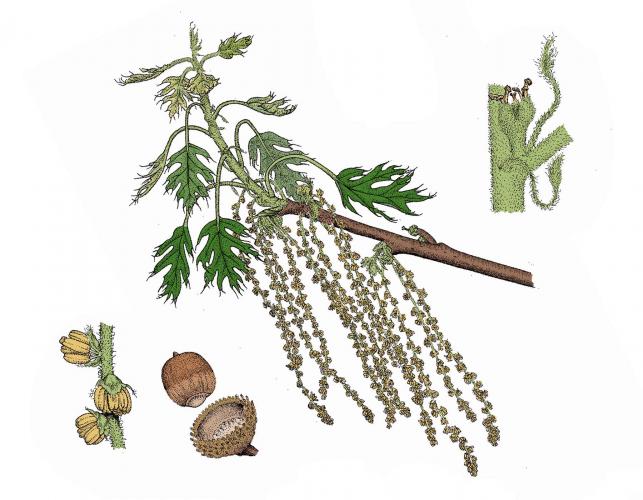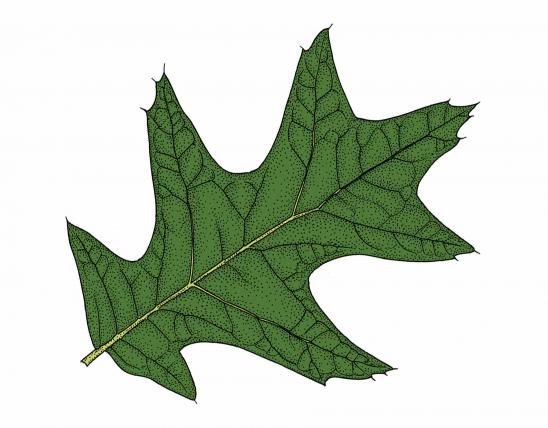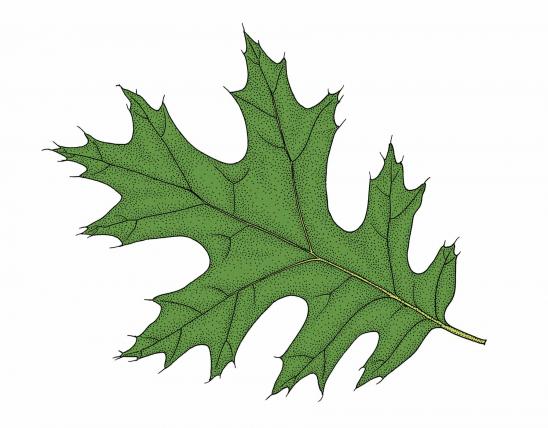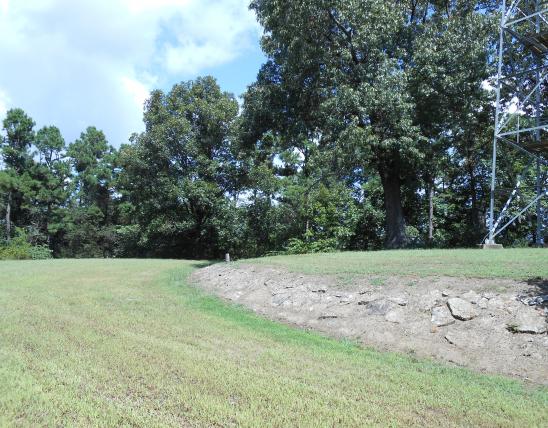
Southern red oak, or Spanish oak, is a large tree with a long, straight trunk, open, rounded crown, and spreading branches.
Leaves are alternate, simple, 7–9 inches long, with a rounded base; variable in shape; with 3–5 bristle-tipped lobes, the first (lowest) pair of lobes are usually the largest and longest, often sickle-shaped, with the notch of the lobes wide and extending nearly to the midvein. Some leaves, particularly those growing in deeply shaded parts of the tree, may have the largest side lobes above the midpoint, with an unlobed tip that is no larger than the lateral lobes. Upper surface dark green, shiny; lower surface paler with light brown to grayish-white matted hairs. Leaves often droop; turn reddish-brown in fall. The 3-lobed leaves are distinctive.
Bark is grayish-black, broken into deep grooves, becoming ridged and rough-plated near the base, not scaly. Inner bark only slightly yellow.
Twigs are stout, reddish-brown, hairy at first, smooth later.
Flowers April–May, in catkins.
Fruits September–October, acorns single or in pairs, brown, faintly striped, round, ½ inch long; cup covering about one-third of the nut, thin, scales flattened, with a reddish-brown dark border, hairy. Ripening in autumn of the second year.
Similar species: The cherrybark oak, or swamp Spanish oak (Q. pagoda) is closely related and has sometimes been considered a subspecies of southern red oak. In Missouri it occurs naturally only in our southeasternmost counties. Its leaves usually have 3 or 4 lobes per side, evenly spaced, with no extra smaller lobes (not 1 or 2 large lobes per side, plus up to 2 smaller lobes); also, there is no narrowly rectangular, unlobed, strap-shaped section at the leaf tip, as there is in southern red oak. The evenly spaced, symmetrical lobes of cherrybark oak look something like the silhouette of a Chinese pagoda (hence the scientific name).
Height: to 90 feet.

Missouri is on the northwestern edge of southern red oak range. It is scattered in southernmost Missouri, north locally to Camden and Perry counties.
Habitat and Conservation
Occurs in bottomland forests, mesic upland forests, savannas, sand savannas, sand prairies, margins of glades, banks of streams and rivers, oxbows, sloughs, and swamps; also roadsides. This species is native to the southeastern United States, and Missouri's southern and Bootheel counties represent one of the northwestern limits of its range.
Status
Why is this native American tree called "Spanish" oak? Among the earliest written references using the name were from William Penn and William Byrd, in the 1600s and 1700s. It doesn't seem to resemble any oaks native to Spain. Some have posited that its leaves resemble some kind of Spanish dagger, or that its fall color is reminiscent of those on the Spanish flag; both theories seem to stretch thin. And along the Atlantic coast, Spain's American colonies did not reach much beyond today's state of Florida, so there is little overlap there with this tree's native range (which is, basically, the southeastern US, but the range does not extend south beyond north Florida). The species name, "falcata," makes more sense. It refers to the falcate lobes of the leaves. "Falcate" describes a shape like a scythe or a scimitar, like a long-tapering, sideways-curving knife, whether it's Spanish or not.
Human Connections
Southern red oaks stand like venerable sentinels over many of America's most deeply historical places, from Texas to Florida to New Jersey, from Mount Vernon to Yorktown, from Natchitoches to Appomattox, from Selma to Montgomery. Its lumber is useful; it makes an excellent shade tree.
Ecosystem Connections
Many species of birds, including woodpeckers and wild turkey, eat the acorns, and so do mice, squirrels, raccoon, and white-tailed deer.






































